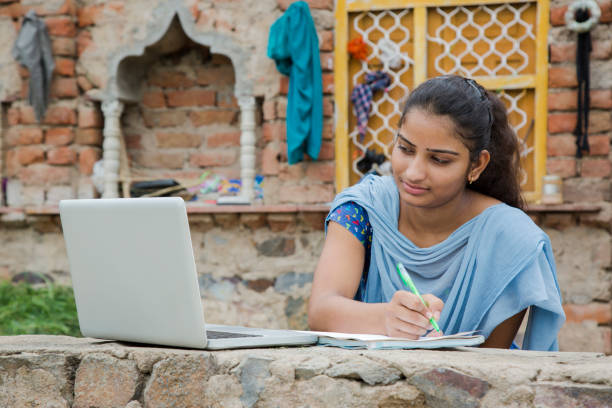Understanding the Rural vs Urban Education Gap
The rural education gap refers to the significant difference in learning opportunities, infrastructure, and outcomes between students in rural and urban areas. Urban schools often have:
-
Qualified teachers
-
Digital classrooms
-
Access to extracurricular programs
-
Better internet connectivity
On the other hand, rural schools may lack even the basic resources needed to ensure quality education. According to several reports, more than 50% of rural students in India struggle with reading comprehension and basic arithmetic.
This gap doesn’t just affect academic performance — it also limits career opportunities, digital literacy, and social mobility for millions of rural students.
How AI Is Revolutionizing Rural Education
AI (Artificial Intelligence) is changing the way rural students learn by making education personalised, accessible, and data-driven. Here’s how:
1. Personalized Learning for Every Student
AI-based platforms can adapt to each student’s learning pace. Tools like Byju’s AI Learning, Google’s Read Along, and Khan Academy analyse student performance and recommend customised lessons. This ensures rural learners get one-on-one support — something that’s often missing in overcrowded classrooms.
2. Breaking the Language Barrier
Many rural students struggle because educational content is mostly available in English or Hindi. AI-powered language translation tools like Google Translate and Duolingo now support regional languages, allowing students to learn in their mother tongue. This helps improve comprehension and inclusivity.
3. Virtual Classrooms and Smart Tutoring
AI-powered chatbots and virtual tutors can answer student questions anytime. For instance, an AI tutor can help a rural student solve a math problem or explain a science experiment even if a teacher isn’t present. Platforms like Vedantu AI and ChatGPT make quality education accessible anywhere.
4. Early Detection of Learning Gaps
AI tools analyse student performance data and identify where learners are falling behind. Teachers can then focus on those specific areas. This proactive approach ensures that no child is left behind — a major step toward closing the rural education gap.
AI’s Role in Empowering Teachers
AI doesn’t replace teachers — it empowers them. Rural teachers often handle large classes with limited resources. AI assists by:
-
Automating attendance and grading
-
Providing real-time feedback
-
Offering AI-driven lesson plans
-
Suggesting engaging activities based on student data
This allows teachers to spend more time mentoring and less time managing paperwork.
Challenges in Implementing AI in Rural Education
While AI brings hope, several challenges must be addressed before it can fully bridge the rural education gap:
-
Limited Internet Access:
Many rural areas still lack stable internet connectivity, making it difficult to use AI-based platforms effectively. -
High Cost of Devices:
Smartphones, tablets, and computers are still unaffordable for many rural families. -
Lack of Digital Literacy:
Both students and teachers need proper digital training to use AI tools confidently. -
Data Privacy Concerns:
AI systems collect large amounts of student data, which must be handled securely to protect privacy. -
Cultural Resistance:
Some rural communities are hesitant to adopt technology-driven education due to traditional beliefs.
Government and NGO Initiatives Supporting AI in Rural Education
Several government schemes and non-profit initiatives are already integrating AI into rural education systems:
-
DIKSHA (Digital Infrastructure for Knowledge Sharing): Offers digital lessons for teachers and students across India.
-
SWAYAM: An online learning platform providing free AI-assisted courses.
-
Pratham Foundation: Uses technology to deliver personalised learning in rural schools.
-
NITI Aayog’s ATL Labs: Encourages AI-based innovation and problem-solving among students in rural India.
These initiatives are creating a strong foundation for equal access to quality education across India.
How AI Can Narrow the Gap Further
To truly close the rural education gap, India needs a multi-layered strategy combining technology with human guidance. Here’s what can help:
-
Affordable AI-Powered Devices
Providing cost-effective tablets and mobile data packs can make digital learning more inclusive. -
Teacher Training in AI Tools
Training rural educators to use AI platforms will improve teaching efficiency and confidence. -
Offline AI Solutions
Developing AI apps that work without the internet can overcome connectivity barriers. -
Public-Private Partnerships
Collaboration between the government, edtech startups, and NGOs can scale AI learning programmes faster. -
Localized AI Content
Creating region-specific AI tools in local languages ensures students understand lessons better.
The Future of AI in Rural Education
AI isn’t just about technology — it’s about equal opportunity. The true power of AI lies in its ability to bring a Delhi classroom experience to a remote village in Odisha or Assam.
As AI evolves, it will help rural students:
-
Access quality teachers online
-
Learn in their preferred language
-
Prepare for national-level exams like NEET, JEE, or UPSC
-
Build digital skills essential for modern careers
The next decade could see AI transforming rural education into a system that’s inclusive, intelligent, and inspiring.
Conclusion: Can AI Truly Bridge the Rural Education Gap?
The answer is yes, but with support. AI alone can’t solve every educational challenge, but it can act as a powerful bridge. With proper infrastructure, digital training, and policy backing, AI can level the playing field for rural and urban students alike.
The rural education gap is not just a technological problem — it’s a social one. AI provides a promising way forward, empowering every child, regardless of where they are born, to learn, grow, and dream equally.

